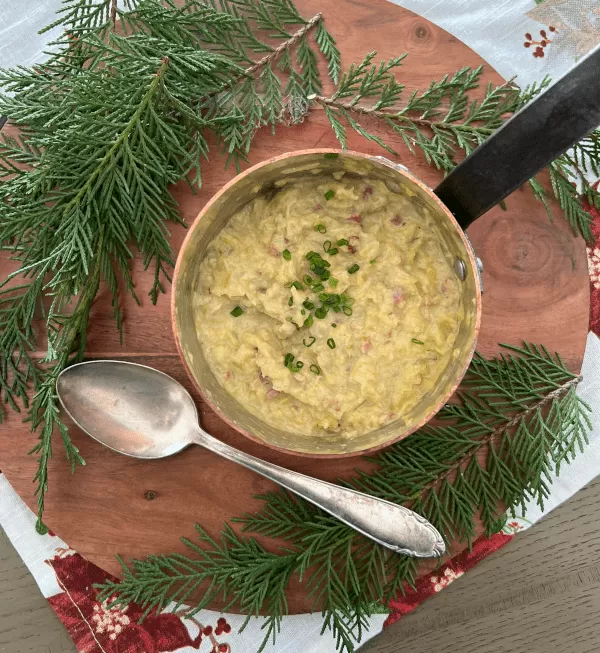12 Oktoberfest Recipes You Can Make At Home For A True Munich Party
Every year, Munich becomes the epicenter of a huge celebration with the arrival of Oktoberfest. It’s not just a festival—it’s a way of life, at least for those few weeks when the city is buzzing with energy. The air is filled with the sounds of traditional Bavarian music, the clinking of beer steins, and, most importantly, the irresistible aromas of hearty, comforting food. I’ve always been drawn to the idea of gathering around a table, sharing platters of sausages, pretzels, roasted meats, and more with friends and family. Even if you can’t make it to Munich, you can bring a slice of Oktoberfest to your own kitchen with some classic dishes that capture the spirit of the festival.
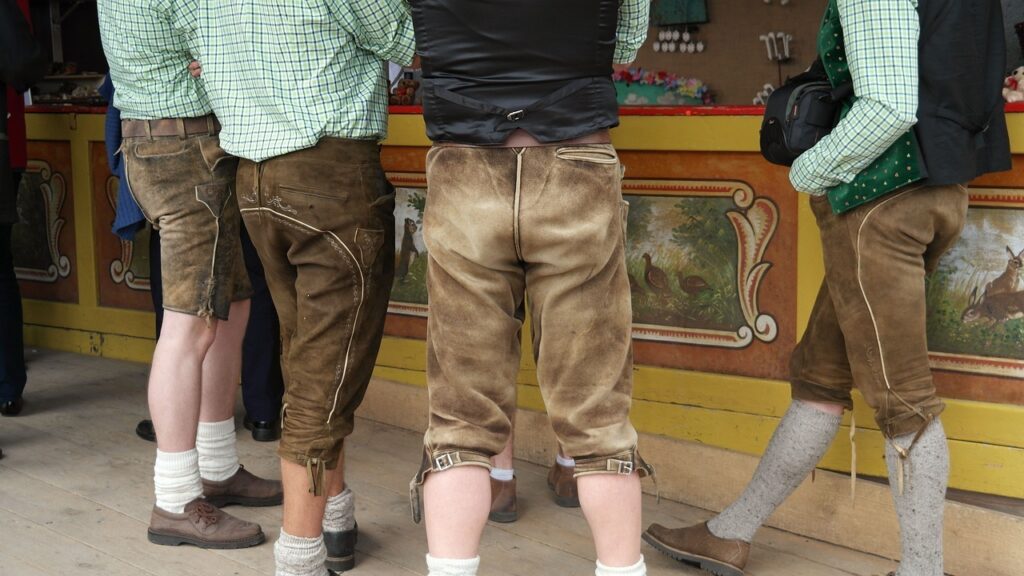
I’ve been celebrating and cooking during Oktoberfest in the United States for as long as I can remember. The Reading Liederkranz, where I first experienced the festival, has been holding an annual Oktoberfest for generations. It has also recently been named one of the best in the United States. Tucked away in the mountains above Reading, Pennsylvania, you truly feel like you are in a beer garden in Germany. At night the party gets wild with the music of local legend Alex Meixner, who’s energetic blend of tradition and contemporary music always gets people dancing. His renditions of songs such as AC/DC’s Thunderstruck and Metallica’s Enter Sandman are crowd pleasers.
When you hear the word “Oktoberfest,” images of large beer steins, people dressed in traditional Bavarian attire, and the joyful sounds of oompah bands might come to mind. Oktoberfest is the world’s largest folk festival, attracting millions of visitors from around the globe each year. But there’s much more to this iconic event than just beer. Let’s dive into the history, some interesting facts, and tips for making the most of your first Oktoberfest experience.
A Brief History of Oktoberfest
Oktoberfest has a rich history that dates back over two centuries. The first Oktoberfest took place on October 12, 1810, to celebrate the marriage of Crown Prince Ludwig (who later became King Ludwig I) to Princess Therese of Saxe-Hildburghausen. The citizens of Munich were invited to join in the festivities, which included horse races and plenty of food and drink. The event was such a success that it was decided to repeat the celebration the following year, and thus, Oktoberfest was born.
Over time, the festival expanded and evolved. In 1811, an agricultural show was added to promote Bavarian agriculture. By the late 19th century, Oktoberfest had grown to include beer tents, carnival rides, and various forms of entertainment. The horse races were eventually discontinued, but the tradition of celebrating with beer and food has remained the heart of the festival.
Today, Oktoberfest is a 16- to 18-day event held annually in Munich, beginning in late September and ending in the first weekend of October. Despite its name, most of the festival actually takes place in September due to the more favorable weather. The festival grounds, known as the Theresienwiese (named after Princess Therese), span over 100 acres and are home to massive beer tents, food stalls, rides, and attractions.

Oktoberfest by the Numbers
Oktoberfest is a colossal event, and the statistics surrounding it are truly staggering. Here are some numbers that give you an idea of the festival’s scale:
- Attendance: Each year, Oktoberfest attracts between 6 and 7 million visitors from all over the world. This makes it the largest beer festival in the world, by far.
- Beer Consumption: During the festival, attendees consume approximately 7 million liters (about 1.85 million gallons) of beer. That’s enough to fill almost three Olympic-sized swimming pools!
- Food Consumption: The food at Oktoberfest is just as important as the beer. Each year, visitors consume around 500,000 roasted chickens, 120,000 pairs of sausages, and nearly 80,000 pork knuckles. Additionally, about 100 oxen and more than 50 calves are roasted on spits.
- Lost and Found: With so many people gathered in one place, it’s no surprise that items get lost. On average, about 4,000 items are turned into the festival’s lost and found each year, including wallets, phones, glasses, and even more unusual items like wedding rings and crutches.
- Security: Safety is a priority at Oktoberfest. Each year, around 600 security personnel and hundreds of police officers are on duty to ensure that the event runs smoothly. There are also medical stations throughout the festival grounds to assist anyone in need.
Interesting Facts About Oktoberfest
- It’s Not Just About Beer: While beer is certainly a major focus, Oktoberfest offers so much more. The festival features a wide range of entertainment, including live music, carnival rides, games, and parades. There’s also a strong emphasis on traditional Bavarian culture, with many visitors donning lederhosen (for men) and dirndls (for women).
- The Beer Tents: There are 14 large beer tents at Oktoberfest, each offering a unique atmosphere. The tents range in size, with the largest, the Hofbräu-Festzelt, accommodating around 10,000 people. Each tent is operated by one of Munich’s traditional breweries, and the beer served is brewed specifically for Oktoberfest, following strict Bavarian purity laws.
- Family-Friendly Events: Oktoberfest isn’t just for adults. The festival offers numerous family-friendly activities, including special family days where ride prices are reduced. There are also traditional parades, such as the Costume and Riflemen’s Procession, that showcase Bavarian heritage.
- The Mayor’s Role: Oktoberfest officially begins when the Mayor of Munich taps the first keg of beer and shouts, “O’zapft is!” (“It’s tapped!”). This tradition dates back to 1950, and it’s one of the most anticipated moments of the festival.
- The Oktoberfest Beer: Traditionally the beer served at Oktoberfest was known as Märzen. It is brewed in March and left to ferment slowly throughout the summer. This beer is slightly stronger than your typical German lager, with an alcohol content of around 6%. Nowadays the tents serve Festbier, which is lighter in color – similar to a Pilsner or lager but with a higher alcohol content. Only beer from Munich’s six major breweries (Augustiner, Hacker-Pschorr, Hofbräu, Löwenbräu, Paulaner, and Spaten) is allowed to be served at the festival.
Some Of My Favorite Recipes For Oktoberfest
1. Homemade Pretzels (Brezn)
Is it even Oktoberfest without a pretzel? I don’t think so. There’s something about the combination of soft, chewy dough and coarse salt that just works, especially when paired with a cold beer. Making pretzels at home might seem like a daunting task, but it’s actually pretty straightforward. The key is in the lye dip and getting that perfect golden brown crust. I like to serve mine with a side of mustard, cut open lengthwise and spread with butter, or if I’m feeling it, a nice cheese dip like Obatzda.
Brezn, or pretzels, are an iconic part of the Oktoberfest experience, offering a perfect balance of soft, chewy dough with a crisp, golden-brown crust sprinkled with coarse salt. These giant, doughy delights are often enjoyed alongside a cold Maß of beer, making them a quintessential snack that complements the festival’s lively atmosphere. The simplicity of the brezn allows it to pair seamlessly with a variety of dishes, from bratwurst to Obatzda, a traditional Bavarian cheese spread. For those who want to bring a taste of Oktoberfest into their own kitchen, making homemade pretzels is easier than you might think. Follow our recipe below to create your own authentic Bavarian brezn, and enjoy a piece of Oktoberfest at home.
Click here for the Homemade Pretzels recipe
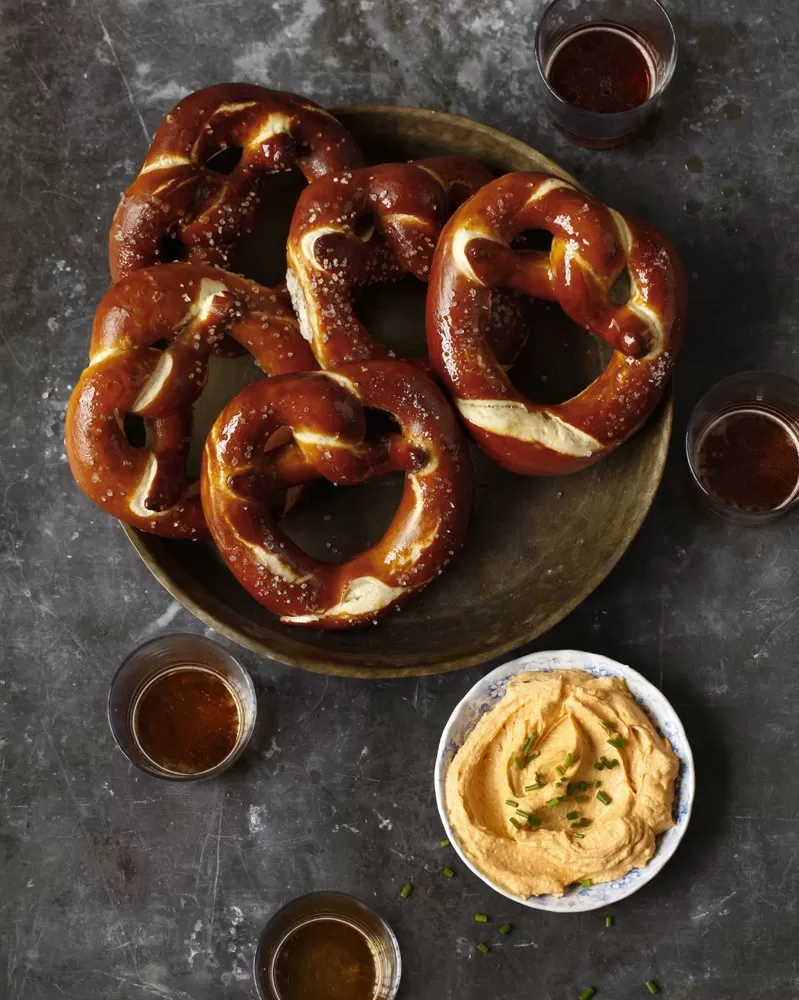
2. Obatzda
Speaking of cheese dip, Obatzda is one of those Bavarian dishes that I can never get enough of. It’s creamy, tangy, and has just the right amount of spice. The base is typically Camembert cheese mixed with butter and a splash of beer, but the magic is in the seasoning. It’s the perfect accompaniment to a warm pretzel or some fresh bread.
Obatzda is a creamy, flavorful Bavarian cheese spread that is a beloved staple in beer gardens and at Oktoberfest. Made primarily from ripe Camembert or Brie, the cheese is mixed with butter, a splash of beer, and a blend of spices such as paprika, caraway seeds, and finely chopped onions. The result is a rich, savory spread with a hint of spice and tang, perfect for slathering on a fresh Brezn or rye bread. Obatzda is often served with radishes, pickles, and onions, making it a hearty snack that pairs wonderfully with a cold Bavarian beer. This dish embodies the essence of Bavarian comfort food—simple, flavorful, and perfect for sharing in a festive setting. Whether enjoyed at a bustling Oktoberfest tent or in a quiet beer garden, Obatzda is a true taste of Bavarian tradition.
Click here for the Obatzda recipe
3. Bratwurst (German Sausages)
German bratwurst, a traditional sausage made from finely minced pork, beef, or veal, is a staple at Oktoberfest, embodying the heart of Bavarian culinary tradition. This flavorful sausage is seasoned with a blend of spices, often including marjoram, nutmeg, and garlic, and then grilled to perfection, giving it a deliciously smoky and savory taste. At Oktoberfest, bratwurst is served in various forms, from simple rolls with mustard to elaborate plates with sauerkraut and pretzels. Its popularity at the festival is unmatched, as it pairs perfectly with the crisp German beers and adds to the festive atmosphere. Whether enjoyed as a quick snack while strolling through the beer tents or as a hearty meal, bratwurst remains an iconic and beloved dish that draws locals and tourists alike to celebrate Germany’s rich culinary heritage. I’ve been making bratwurst for a long time. We sold more bratwurst at Brauhaus Schmitz than anything and it’s really tasty. It’s no surprise that it won Best of Philly twice!
Click here for the Bratwurst recipe
4. Schweinshaxe (Roast Pork Knuckle)
There probably isn’t one dish that screams Oktoberfest, but Schweinshaxe could definitely be considered. This roast pork knuckle is a Bavarian staple, known for its crispy skin and tender meat. It takes a bit of time to cook, but the result is well worth it. I love serving this with some sauerkraut and potato dumplings—it’s the kind of meal that brings everyone together.
Schweinshaxe, or roasted pork knuckle, is a hearty and beloved dish that holds a special place at Oktoberfest and in German cuisine. This traditional Bavarian specialty features a large, meaty pork knuckle, seasoned and slow-roasted until the skin becomes irresistibly crispy, while the meat inside remains tender and flavorful. Often served with classic sides like sauerkraut, potato dumplings, or mashed potatoes, Schweinshaxe is a meal that showcases the robust flavors of German cooking. At Oktoberfest, this dish is a crowd favorite, offering a satisfying, protein-packed option that pairs perfectly with the festival’s plentiful beer. Beyond the festive tents, Schweinshaxe is enjoyed throughout Germany, especially in Bavarian beer gardens and traditional restaurants, where it symbolizes the country’s love for hearty, comforting meals that bring people together. Whether you’re at Oktoberfest or exploring Germany, Schweinshaxe is a must-try dish that truly represents the rich culinary heritage of the region.
Click here for the Schweinshaxe recipe
5. Käsespätzle (Cheese Noodles)
Käsespätzle is like the German version of mac and cheese, but I would say it’s even better. Spätzle, which are little egg noodles, are layered with cheese and caramelized onions, baked, and then topped with crispy onions. It’s the ultimate comfort food, especially when you’re in the mood for something rich and satisfying. Trust me, once you make this dish, it’ll become a regular in your kitchen.
Käsespätzle is a comforting and indulgent dish that stands as Germany’s answer to macaroni and cheese, although it probably has been made in Germany long before macaroni and cheese was made in the States. Beloved across the country and particularly in the southern regions, this hearty dish consists of soft, egg-based noodles, known as Spätzle, which are cooked to perfection and then layered with a generous amount of grated cheese, typically Emmental or Allgäu cheese, and caramelized onions. This mix is then baked until the cheese melts and forms a creamy, gooey consistency, often topped with crispy fried onions for an added burst of flavor and texture. Käsespätzle is a popular choice at Oktoberfest and in German households, especially during the cooler months, as it offers a warm and satisfying meal that embodies the essence of German comfort food. Whether enjoyed as a main dish or a side, Käsespätzle is one you’ll want to add to your repertoire of German culinary dishes, bringing together simple ingredients in a dish that is both nourishing and deeply satisfying.
Click here for the Käsespätzle recipe
6. Bavarian Sauerkraut
Bavarian-style sauerkraut is a quintessential side dish that adds a tangy and flavorful contrast to hearty German meals. Unlike its more straightforward counterparts, Bavarian sauerkraut is often cooked with ingredients like bacon, onions, apples, and a touch of caraway seeds, which infuse it with a rich, savory-sweet flavor profile. This slow-cooked version is less sour than traditional sauerkraut, offering a milder, more nuanced taste that pairs perfectly with dishes like bratwurst, Schweinshaxe, or Käsespätzle. The addition of apples brings a subtle sweetness that balances the tanginess of the fermented cabbage, making it a delightful complement to the robust flavors of Bavarian cuisine. Whether served at Oktoberfest or at a cozy family dinner, Bavarian-style sauerkraut is a beloved side dish that highlights the region’s culinary tradition of turning simple ingredients into something truly special.
Click here for the Bratwurst with Sauerkraut recipe
7. Bavarian Potato Salad (Kartoffelsalat)
Potato salad is one of those side dishes that I can never get enough of, especially the Bavarian version. Unlike the creamy, mayonnaise-based salads you might be used to, this one is dressed with a tangy vinaigrette, making it lighter and more flavorful. It’s the perfect accompaniment to all the rich meats you’ll be serving up.
Bavarian-style potato salad, or Kartoffelsalat, is a classic dish served in restaurants, Gasthäuser, and at Oktoberfest, known for its light and tangy flavor profile. Unlike other regional variations of potato salad, the Bavarian version is typically made without mayonnaise or bacon, focusing instead on the simplicity of its core ingredients. The potatoes are boiled, sliced, and then tossed in a dressing made from vinegar, oil, mustard, and a bit of broth, creating a tangy and refreshing dish. Fresh herbs, like parsley or chives, are often added to enhance the flavor, and the salad is sometimes finished with finely chopped onions for a bit of bite. This potato salad is a perfect accompaniment to many Bavarian dishes, from schnitzel to grilled sausages, as its acidity cuts through the richness of the meats, making it a popular choice in both casual and festive settings. Its lightness and versatility make it a staple at Oktoberfest, where it is enjoyed by locals and tourists alike as part of the quintessential Bavarian culinary experience.
Click here for the Bavarian Potato Salad recipe
8. Krautsalat (Cabbage Salad)
Krautsalat is a fresh and crunchy cabbage salad that offers a nice contrast to the rich meats of Oktoberfest. It’s dressed with a light vinaigrette, which makes it a refreshing side dish. This simple yet flavorful salad is one of my go-to dishes when I need something easy to prepare but still want a taste of Bavaria.
Krautsalat, or German cabbage salad, is a refreshing and tangy side dish that is a staple in German cuisine, particularly in the southern regions like Bavaria. Made from finely shredded white cabbage, Krautsalat is typically dressed with a simple yet flavorful mixture of vinegar, oil, and a touch of sugar, often seasoned with salt, pepper, and caraway seeds for an added depth of flavor. Unlike the creamy coleslaw found in other countries, Krautsalat is lighter and has a distinct tanginess that comes from the vinegar, making it an excellent accompaniment to rich, hearty dishes such as sausages, schnitzel, or roast pork. Sometimes, the cabbage is briefly wilted in hot water before being dressed, which softens its texture while preserving its crunch. This salad is not only popular in homes and restaurants but is also commonly enjoyed at beer gardens and festivals like Oktoberfest, where it serves as a crisp, palate-cleansing contrast to the heavier fare. Krautsalat embodies the German culinary tradition of making the most of simple, seasonal ingredients to create dishes that are both satisfying and full of flavor.
Click here for the Krautsalat recipe
9. Rahmschwammerl (Creamy Mushrooms with Bread Dumplings)
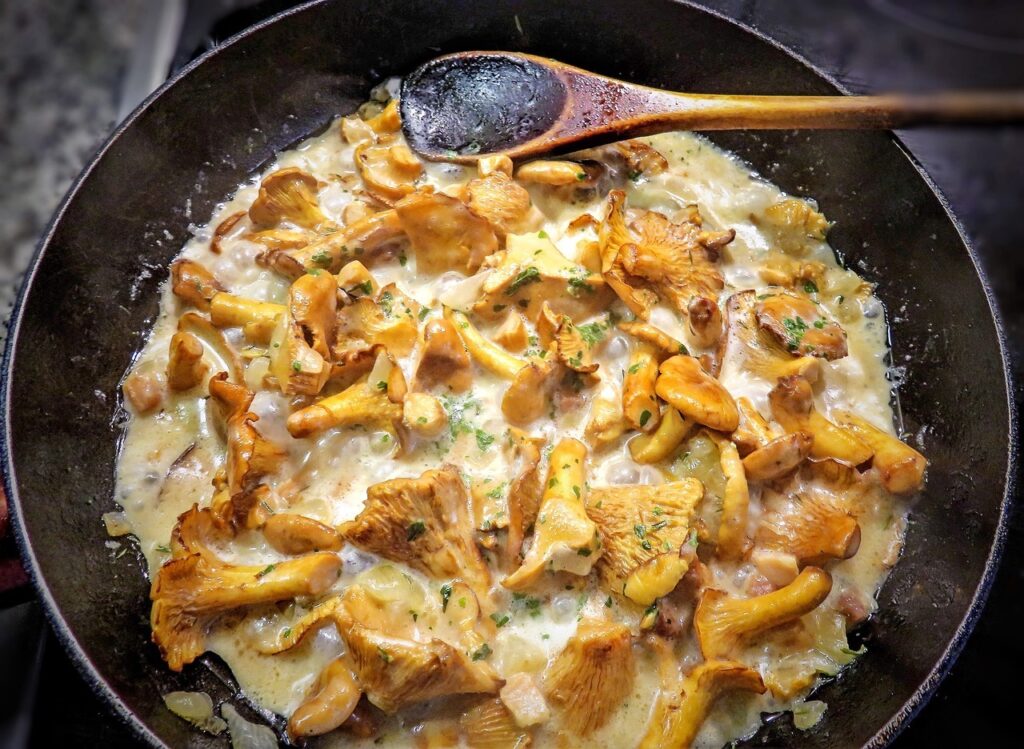
Rahmschwammerl, or creamy mushrooms, is a delicious and comforting Bavarian dish that showcases the rich flavors of earthy mushrooms cooked in a velvety cream sauce. This dish typically features a variety of wild mushrooms, such as chanterelles or porcini, which are sautéed with onions and garlic until they release their deep, woodsy aroma. The mushrooms are then simmered in a sauce made from heavy cream, broth, and sometimes a splash of white wine, creating a luscious, savory dish with a hint of tanginess. Rahmschwammerl is often seasoned with fresh herbs like parsley or thyme, adding a fragrant note that complements the richness of the sauce. Traditionally, it is served with soft, pillowy dumplings, such as Semmelknödel or Spätzle, which are perfect for soaking up the creamy sauce. Whether enjoyed as a main course or a side dish, Rahmschwammerl is a beloved part of Bavarian cuisine, offering a taste of the region’s love for hearty, comforting flavors.
Click here for the Rahmschwammerl recipe
10. Roast Chicken (Hendl)
Roast chicken is a simple dish, but when done right, it’s incredibly satisfying. At Oktoberfest, you’ll see plenty of roast chickens being passed around, often served with a side of potato salad or pretzels. The key is getting the skin nice and crispy while keeping the meat tender and juicy.
Bavarian Roast Chicken, known locally as Hendl, is a beloved dish that captures the essence of traditional Bavarian cooking. This simple yet flavorful dish is a staple at Oktoberfest, where the sight of golden, crispy roast chickens turning on spits is as iconic as the beer itself. Hendl is typically seasoned with a blend of spices that can include paprika, salt, pepper, and marjoram, which infuse the meat with a rich, savory flavor while creating a beautifully crispy skin. The chicken is roasted to perfection, resulting in tender, juicy meat that pairs wonderfully with classic sides like potato salad, sauerkraut, or a freshly baked pretzel. Whether enjoyed at a bustling beer tent during Oktoberfest or in the cozy setting of a traditional Bavarian Gasthaus, Hendl offers a taste of comfort and tradition, making it a favorite among locals and visitors alike. Its straightforward preparation and irresistible flavor make Bavarian Roast Chicken a timeless dish that continues to delight those who experience it.
Click here for the Roast Chicken recipe
11. Apfelstrudel (Apple Strudel)
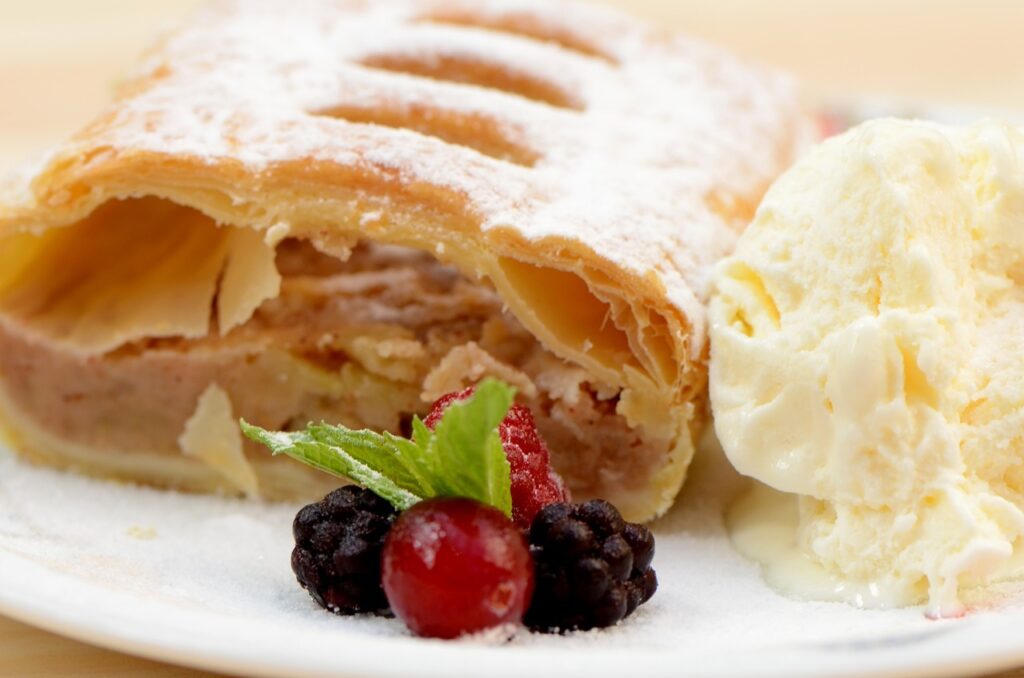
No Oktoberfest meal is complete without dessert, and Apfelstrudel is the perfect way to end your feast. This classic pastry is filled with spiced apples and raisins, all wrapped in a flaky crust. Making strudel dough from scratch can be a bit tricky, but the results are worth it. Plus, your kitchen will smell amazing.
Apfelstrudel, or apple strudel, is a classic dessert that holds a special place in the heart of Bavarian and Austrian cuisine. This delectable pastry is made by wrapping a thin, flaky dough around a filling of tart apples, sugar, cinnamon, raisins, and breadcrumbs, creating a perfect balance of sweet and spicy flavors. The dough, traditionally stretched by hand until it is almost paper-thin, becomes wonderfully crisp during baking, while the apple filling turns soft and fragrant, filling the kitchen with an irresistible aroma. Apfelstrudel is often served warm, dusted with powdered sugar, and accompanied by a dollop of whipped cream or a scoop of vanilla ice cream, making it a comforting treat that is both light and satisfying. Whether enjoyed in a cozy café, at a festive gathering, or as a special homemade dessert, Apfelstrudel embodies the rich pastry traditions of the region, offering a delightful blend of textures and flavors that have made it a favorite for generations.
Click here for the Apfelstrudel recipe
12. Kaiserschmarrn
To round off the meal, I recommend Kaiserschmarrn. This fluffy, shredded pancake is slightly caramelized and served with a dusting of powdered sugar and a side of fruit compote or applesauce. It’s a fun and satisfying dessert that’s easy to make but always impresses.
Kaiserschmarrn is a beloved Austrian and Bavarian dessert that transforms a simple pancake into a decadent treat fit for royalty. This dish, whose name translates to “Emperor’s Mess,” is made from a fluffy, slightly sweet batter that is cooked like a large pancake, then torn into bite-sized pieces while still in the pan. The pieces are caramelized to a golden brown and sprinkled with powdered sugar, creating a delightful contrast between the soft, airy interior and the slightly crisp edges. Traditionally, Kaiserschmarrn is served with a side of fruit compote, such as stewed plums or apples, which adds a touch of tartness to balance the sweetness of the dish. Its origins are steeped in legend, with some stories suggesting it was a favorite of Emperor Franz Joseph I of Austria. Whether enjoyed as a dessert or a sweet main course, Kaiserschmarrn is a comforting and indulgent dish that captures the essence of alpine culinary tradition, making it a favorite in both homes and alpine huts throughout the region.
Click here for the Kaiserschmarrn recipe
There you have it—twelve recipes that will help you bring the Oktoberfest experience to your own home. Whether you’re planning a big feast or just want to try a few dishes, these recipes are a great way to celebrate the flavors of Bavaria. Remember, Oktoberfest is all about enjoying good food, good beer, and good company, so don’t stress too much about getting everything perfect. Have fun with it, experiment, and most importantly, enjoy the process. Prost!



